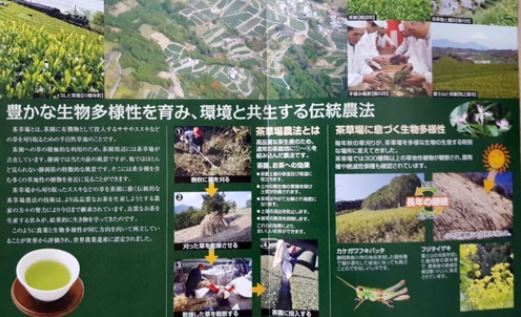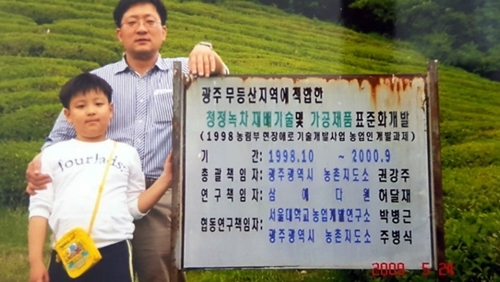Korean scholar lays claim to Japan’s globally recognized tea farming system
By Bak Se-hwanPublished : Aug. 29, 2017 - 16:54
A new tea farming method that Japan registered as its own agricultural heritage with a UN body last year is not uniquely Japanese as touted, as a study in Korea precedes it by many years, a local scholar has claimed.
The tea production system -- officially designated Japan’s Globally Important Agricultural Heritage Systems by the Food and Agriculture Organization of the United Nations -- involves growing native grass between tea bushes to help enhance the soil and encourage biodiversity.
The tea production system -- officially designated Japan’s Globally Important Agricultural Heritage Systems by the Food and Agriculture Organization of the United Nations -- involves growing native grass between tea bushes to help enhance the soil and encourage biodiversity.

The same approach was academically studied, experimented with and introduced by Park Byung-gun, a food science professor at Gangneung Yeongdong University and vice president of the International Society of Tea Science.
Park’s research, which was funded by South Korea’s Agriculture Ministry, ran from 1998 to 2000 and was published in the 2001 International Conference on O-CHA (Tea) Culture and Science, he said.
The professor said he had even presented a preliminary paper in 2001 at an international conference held in Japan’s Shizuoka prefecture, the region that registered it with the FAO.
Another of Park’s research papers, published in 2009 and titled “Systemization of Pure-Clean Green Tea Cultural Practice Utilizing Low Input Sustainable Agriculture System by Sod Culture,” also described the benefits of the sod culture in tea farming, ideal for areas in the Mudeung mountain region of Gwangju in particular.
His research suggested that growing native grasses like rye, oat orchard grass and red clover between tea fields allows herbicide-free farming of green tea. In late fall, the grass is cut to be spread between the rows of tea bushes, adding nutrients to the soil and protecting tea plants during winter. In this way, farmers can improve the overall quality of green tea as well as support the growth of many other varieties of smaller plants, the scholar claimed.

Despite his study, the method is not widely practiced among local tea farmers.
Japan’s Chagusaba, or tea-grass integrated system, designated as among the heritage systems in 2016, is essentially identical in its approach, Park said. Shizuoka prefecture describes Chagusaba as a farming method that originated in Shizuoka prefecture near Mount Fuji thousands of years ago.
But Park claims this use of grass areas did not exist before he invented it.
“The environmentally friendly agriculture system for tea production has been researched and developed by South Korea long before, and now it’s internationally designated as Japan’s own agricultural heritage,” Park told The Korea Herald.
“The Ministry of Agriculture, Food and Rural Affairs here should take the issue seriously and put in more effort to help our own farming technique to be recognized as such,” Park said.
An official from the Agriculture Ministry said it is closely following Park’s claim and his studies, and will discuss the issue with the FAO later if necessary.
By Bak Se-hwan (sh@heraldcorp.com)


![[AtoZ into Korean mind] Humor in Korea: Navigating the line between what's funny and not](http://res.heraldm.com/phpwas/restmb_idxmake.php?idx=644&simg=/content/image/2024/04/22/20240422050642_0.jpg&u=)

![[Exclusive] Korean military set to ban iPhones over 'security' concerns](http://res.heraldm.com/phpwas/restmb_idxmake.php?idx=644&simg=/content/image/2024/04/23/20240423050599_0.jpg&u=20240423183955)

![[Herald Interview] Why Toss invited hackers to penetrate its system](http://res.heraldm.com/phpwas/restmb_idxmake.php?idx=644&simg=/content/image/2024/04/22/20240422050569_0.jpg&u=20240422150649)
![[Graphic News] 77% of young Koreans still financially dependent](http://res.heraldm.com/phpwas/restmb_idxmake.php?idx=644&simg=/content/image/2024/04/22/20240422050762_0.gif&u=)






![[Exclusive] Korean military to ban iPhones over security issues](http://res.heraldm.com/phpwas/restmb_idxmake.php?idx=652&simg=/content/image/2024/04/23/20240423050599_0.jpg&u=20240423183955)



![[Today’s K-pop] Ateez confirms US tour details](http://res.heraldm.com/phpwas/restmb_idxmake.php?idx=642&simg=/content/image/2024/04/23/20240423050700_0.jpg&u=)